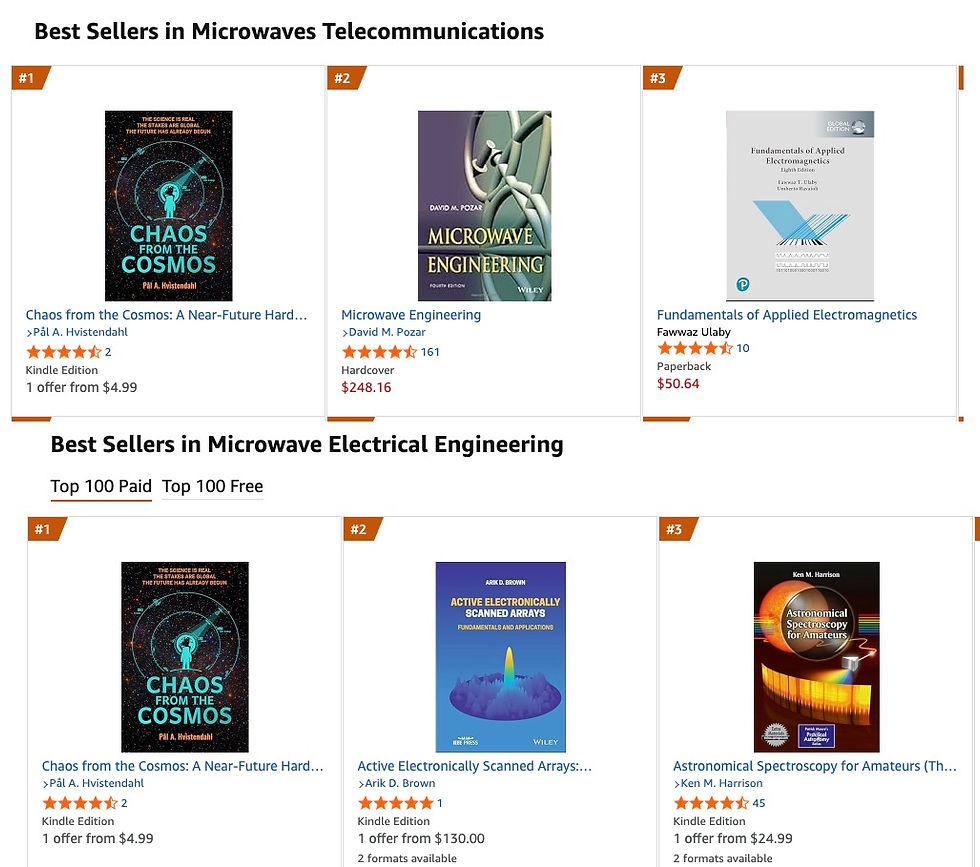Why 'CHAOS FROM the cosmos' is an amazon #1 best-seller in Microwave categories?
- P.A. Hvistendahl
- Jun 30
- 3 min read

We tend to think of microwaves as something inside your kitchen, but in the context of space, they’re one of the most essential technologies we have. Microwaves are the unsung heroes of space technology.
The backbone of space communication
Without microwaves there would be no satellite TV, no GPS or Galileo navigation, no weather forecasts, and no satellite internet.
Why? Because microwaves reliably penetrate Earth’s atmosphere and carry high-bandwidth data across vast distances—making them ideal for communication between satellites, spacecraft, and ground stations.
Some examples
Space-Based Solar Power (SBSP): Beaming energy
Looking further ahead, there’s growing momentum around space-based solar power—collecting solar energy in orbit or on the Moon and transmitting it via microwaves to where it's needed.
The European Space Agency (ESA) is actively studying this concept, and it inspired scenes in Chaos from the Cosmos.
Imagine this:
A solar array sits on a permanently sunlit ridge near the Moon’s south pole.
It converts sunlight into a microwave beam.
That beam transmits energy to a rover operating in a pitch-black crater.
The rover receives and converts the beam into electricity—no batteries, no sunlight, no nuclear fuel.
This isn’t just sci-fi. ESA has examined millimeter-wave power transmission for lunar infrastructure, and concepts like this could support long-term exploration.
Why microwaves?
Operate day or night (with relays or orbital platforms)
Penetrate lunar dust and fog
Deliver power with directional precision
Often more efficient over mid-range distances than lasers
Radar: Seeing beneath the surface
Microwaves don’t just carry power and data—they help us see underground through radar systems.
Discovering:
Subsurface layers
Hidden lava tubes
Potential water-ice deposits in permanently shadowed lunar regions
These insights are critical for:
Finding safe landing sites
Selecting base construction zones
Locating essential resources for human survival
Microwave radar is also key in Earth observation. Sentinel-1 sees through clouds and darkness, and other satellites measure:
Soil moisture (vital for agriculture and weather models)
Sea surface salinity (for ocean circulation and climate)
Sea ice thickness
Atmospheric profiles (temperature, humidity, rainfall)
Microwaves enable this by detecting natural thermal emissions—a passive but powerful way to monitor Earth’s changing systems.
In-Situ Construction
One lesser-known use of microwaves is in processing lunar soil, or regolith:
Microwaves can heat and fuse the dusty surface, a process called sintering.
This can create landing pads, habitat bricks, or radiation shielding—all from local materials.
ESA and other agencies are researching this now. And yes, it inspired scenes in Chaos from the Cosmos—where local construction isn’t a choice, it’s a survival strategy.
And there is much more that could be mentioned on microwaves and space, and future applications that have not yet emerged. But I hope to have convinced you that without microwaves, we will not go very far. And we will not thrive.
Sidebar: What about lasers?
Yes—lasers can and will be used too.
When it comes to wireless power and space communication, microwaves and lasers each have their place:
Microwaves are ideal for rugged, variable environments like the lunar surface. Or, bringing space power to Earth. Lasers shine in clear-space scenarios where precision and data speed dominate. For example, satellite internet for Earth.
Lasers offer narrow beams and higher data rates, perfect for inter-satellite links and high-throughput comms.
Microwaves are more forgiving—ideal for powering rovers, working through dust, and beaming energy in unstable or partially obstructed environments.
I explore these microwave (and laser) technologies—and what happens when they go wrong—in my hard sci-fi novel, Chaos from the Cosmos. I didn’t lock into one technology. The focus is not on confusing you on technological details but unveil realistic applications—and what happens when those systems fail, evolve, or become mission-critical.
Now available for Kindle:📚 Amazon US📚 Amazon UK📚 Amazon France📚 Amazon Germany
There’s power-beaming. There’s water on the Moon. There’s geopolitics, survival, and discovery.
And it all builds from today’s real science.
Ad Astra! To the Stars!




Comments